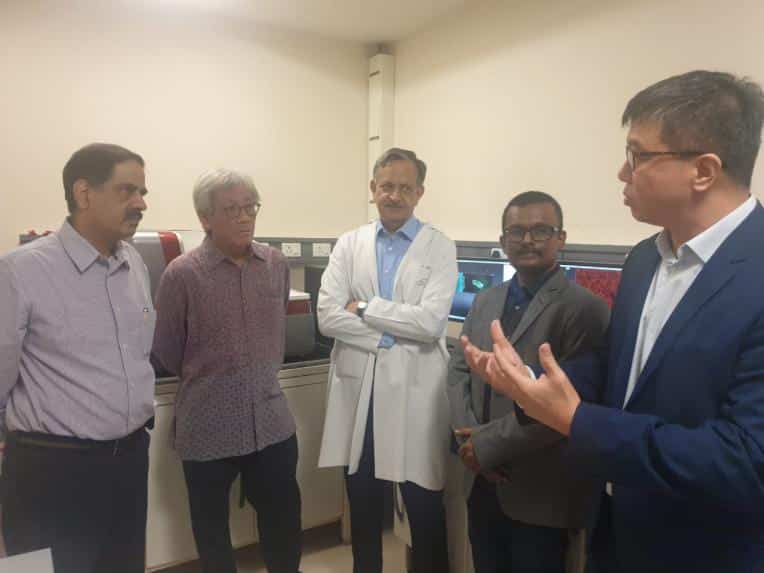HistoIndex and ILBS Launch Centre of Excellence in New Delhi for Advanced Diagnostics and Clinical Research on Nonalcoholic Steatohepatitis (NASH)

[Picture by Enterprise Singapore. From Left] Professor Balram Bhargava, Director General, Indian Council of Medical Research; Secretary, Department of Health Research, India, Mr Lim Thuan Kuan, High Commissioner of the Republic of Singapore in New Delhi, Professor Shiv Kumar Sarin, Director, ILBS, Dr Anand Soshee, Managing Director, Medical Imaging Services (India), and Dr Gideon Ho, Chief Commercial Officer, HistoIndex.
SINGAPORE and NEW DELHI, Aug. 7, 2019 – In a cross-border collaboration, HistoIndex and the Institute of Liver & Biliary Sciences (ILBS) in New Delhi, India have jointly launched a Centre of Excellence (CoE) to aid diagnostics and clinical trials focusing on NASH. The CoE is HistoIndex’s first Genesis Imaging Service (GIS) partner in India and joins the company’s global network of medical, academic and referral laboratory partners who are involved in comprehensive clinical and scientific studies on NASH and other chronic liver conditions. The CoE was launched today during the Dr V. Ramalingaswami Oration and Hepatopathology Meeting 2019 at the ILBS.
The CoE – an integration of HistoIndex’s AI-based digital pathology expertise and ILBS’s superior position as a national clinical and research institute for Hepatology – will be recognised as a top-notch clinical and research facility that will ultimately benefit the treatment options of patients afflicted with NASH or similar liver conditions.
NAFLD is emerging as the most common amongst liver diseases in India, where 1 in 4 adults suffer from fatty liver disease.The true prevalence is even higher and often these remain undiagnosed because of lack of any clinical symptoms. A modern lifestyle with high-calorie diets and less physical activity have resulted in an exponential increase in NAFLD in Indian population. NAFLD in India is seen in a substantial number of physically lean and normal weight Indians as a higher insulin resistance and higher triglycerides in blood, making them more susceptible.
Says Professor Shiv Kumar Sarin, Director of the ILBS, “ILBS is constantly working towards the mission of developing a facility with international standards, which consists of a comprehensive and modern setup for diagnosis and treatment, and an advanced centre for the dedicated research and training in the field of liver diseases, including liver transplantation, gall bladder and biliary diseases, and allied specialties. We are pleased to collaborate on the CoE in SHG imaging, which will be the first of its kind in India with immense potential to serve our country’s healthcare sector.”
Distinguished guests in attendance at the launch included Professor Balram Bhargava, Secretary, Department of Health Research, (Ministry of Health & Family Welfare), Government of India and Director General, Indian Council of Medical Research (ICMR), and Mr Lim Thuan Kuan, High Commissioner of Singapore in New Delhi.
Large Clinical Interest for Advanced NASH Diagnostics
HistoIndex’s SHG digital pathology will be the core of the CoE, serving India’s enormous clinical and research interests for better histopathological standards in the assessment of NASH, which is on the rise in the country. In addition, the CoE will be the perfect training site for pathologists to equip themselves with the skills necessary to work with AI-based digital pathology. With the adoption of the technology, pathologists will be able to analyse and quantify NASH characteristics such as fibrosis, steatosis, ballooning and inflammation. This will:
- Determine treatment efficacies during clinical trials, where the data generated by the SHG imaging and algorithms will allow pharmaceutical and biotech companies to design their later stage clinical trials and develop new treatments.
- Allow clinicians to make critical decisions and potentially determine a patient’s ability to receive or respond to treatment.
Mr Tay Lian Chew, Global Markets Director for South Asia, Enterprise Singapore said, “Enterprise Singapore works closely with Singaporecompanies to build their capabilities and expand overseas. Having connected Histoindex with ILBS, it is encouraging to see them partner each other to launch this CoE, which will be HistoIndex’s first foray into the India market. The CoE is a testament to how Singapore companies can partner Indian healthcare players to enhance healthcare delivery with innovative technology and solutions.”
SHG: A Competent Digital Pathology and Analytics Tool for NASH Clinical Trials
HistoIndex’s SHG technology is currently involved in more than 10 NASH and Hepatitis B FDA clinical trials. Over the past ten years, the Singapore-based company has assisted in many preclinical and clinicial studies with SHG, to generate data with a continuous-scale measurement to objectively quantify fibrotic changes in liver biopsies.
Says Dr Gideon Ho, Chief Commercial Officer of HistoIndex, “HistoIndex is honoured to partner with an esteemed institution like ILBS to tackle the NASH epidemic head-on in India with patient-centric and evidence-based diagnostics. Furthermore, we are glad to play a role in helping the Indian medical community to better manage the clinical care for patients suffering from NASH. This condition is reversible if the appropriate treatment is administered early, and we are in the race to help pharmaceutical companies discover the most effective treatment for NASH.”
About NASH
A chronic and prevalent liver condition that plagues populations battling obesity and diabetes, NASH is in the waitlist for an effective treatment. Trends highlighted by a study indicate that the prevalence of NASH is expected to increase by 63% between 2015 and 2030 (Chris Estes, Hepatology 2018). Multiple clinical trials are in the race towards treatments that could possibly decrease liver fat, inflammation or ballooning, while others aim to reduce fibrosis. If it progresses, fibrosis can lead to liver cirrhosis or liver cancer.
